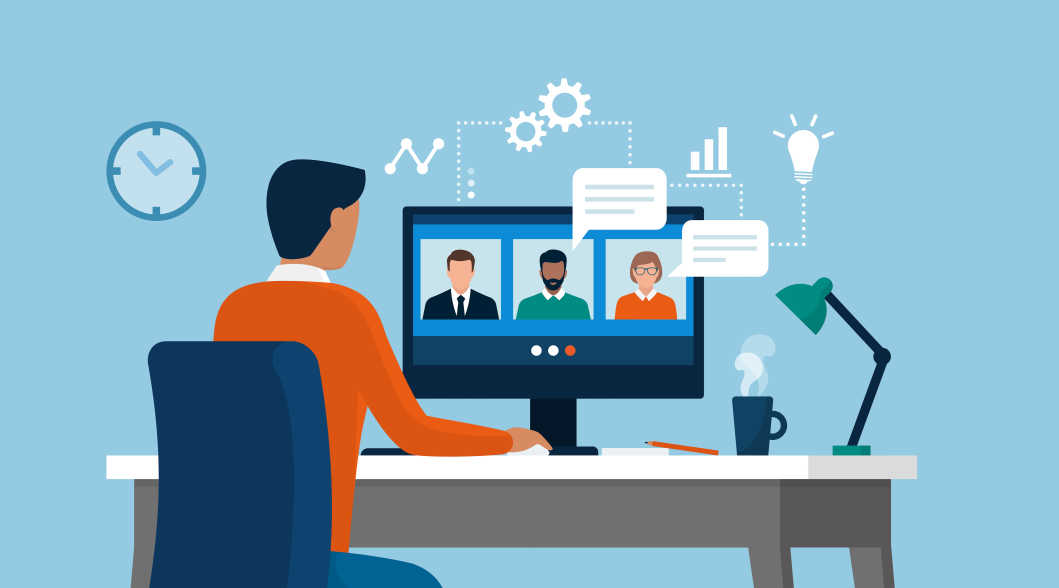5 Ways to Overcome Work from Home Challenges
COVID-19 has changed the way we work. Companies and workers alike have adapted to a work-from-home culture and everyone is getting used to the new normal.
- Hinge Health Learning Center
- Articles
- 5 Ways to Overcome Work from Home Challenges
Our Hinge Health Experts
Dr. Ryan Sharkey, DPT
COVID-19 has changed the way we work. Companies and workers alike have adapted to a work-from-home culture over the past six months, and everyone is getting used to the new normal.
Now that many workers have settled into the idea that working from home will be the plan for some time (if not permanently), how are people really getting by? Most importantly, how has this massive transformation of the workforce affected us physically?
What the work-from-home workforce really looks like
According to a recent Hinge Health survey report “New Health Risks in the Remote Workplace,” participants identified interesting characteristics of their work-from-home lives:
2 of 3 people are new to working from home
45% of all workers have low back or joint pain
78% work in a shared space like a living room, dining room, or bedroom
These are just a few of the many attributes of remote working that have become apparent over the past six months. As a physical therapist at Hinge Health, I regularly discuss these issues with our participants every day. Here are five common challenges and how to overcome them.
5 work from home challenges and how to overcome them
1. Offices are makeshift, and desk setups are challenging
“I’m working from home, so my desk setup isn’t the best” is the most common complaint I hear when I talk to our Hinge Health participants. Makeshift offices can be awkward, and many remote workers have been making do for far too long. While no desk setup is perfect, finding ways to create a comfortable space can help.
Advice: Give some space between yourself and your screen. Having your screen at arms length can make looking at a screen and sitting at a workstation more comfortable. Make sure you are looking at your monitor at eye-level and avoid looking down at your laptop or monitor to reduce neck and shoulder pain. We also may be sitting too much and not moving enough which can affect your back and other joints. If you can purchase a standup desk that might be helpful to break up your day, especially for long-term remote workers.
2. Rookie remote workers are unsure when to take breaks
Frequent movement and exercise breaks have been shown to significantly reduce the risks of sedentary work. But new remote workers have a difficult time understanding when, and more importantly how, to take breaks. This is a challenge that desk workers must confront, especially as studies continue to suggest that sedentary behavior, such as prolonged sitting at work, increases exposure to occupational hazards such as back pain and mental health issues. The best ergonomic workstation is the one you can regularly push away from to take a quality break from work to move and exercise. A study published in the Journal of Applied Ergonomics found that taking regular three-to-four-minute “microbreaks” two or three times an hour throughout the day has a significantly positive effect on desk workers' pain without causing any detriment to overall productivity.
Advice: Take breaks, and take them frequently! Get up from your workstation every 30 minutes or so and take a stretch break. Moving around and changing positions is a healthy way to keep your body from feeling fatigued. Read 5 Ways to Incorporate Movement While Working from Home.
Jack, a Hinge Health participant, told me he was sitting for long periods of time at his job which made his back pain worse. Together we made a plan to get up, stretch, and move for 5 minutes every hour, which significantly improved his back pain both throughout the day and at night. In fact, Jack shared by stretching regularly, he was able to mow the lawn weekly without causing pain at night - something he hadn’t been able to do in a year.
3. Finding work–life balance is more difficult
Most participants in our Hinge Health survey reported working about the same number of hours at home as they had at the office, and about 30% of participants reported working more hours. This doesn’t tell the whole story, however. Regular routines that used to include work, exercise (perhaps at a gym), and home life have been blurred and disrupted. It can be hard to follow a workout routine when your gym is closed or you’re hesitant to go, and finding viable alternatives to an established routine is easier said than done. A recent study of allied health professionals revealed that there has been a significant decrease in physical activity. since the COVID-19 pandemic began.
Advice: Set yourself up for success by making it easy to transition from work to your personal life at home. Our bodies respond to “cues” that help us get into one habit or another, and changing from office to remote work has drastically interrupted those cues. If you used to walk during your commute, you may want to mimic this transition from work to life with a hike or yoga after work. If you are having a hard time walking or exercising before or after work, try to remember to put your exercise clothes in plain sight, like in front of your front door or near your workstation, so you remind or “cue” yourself to get into the habit of exercise. Read 4 Actionable Ways to Improve Work-Life Balance During Remote Work.
4. Mental health is suffering
In the last six months, numerous Hinge Health participants have said to me, “It feels like the walls are closing in on me.” In fact, 45% of the employees in our study reported stress, anxiety, or depression, with 71% of that group indicating that those mental health issues have worsened in the past six months. According to Harvard Health Publishing, stress, anxiety, and depression have all been shown to significantly increase our bodies’ sensitivity to pain, and they are correlated with increased pain from chronic conditions.
Advice: Have someone to talk to you that you trust about how you are feeling. Even a small discussion with a close friend can be helpful for you to share some of your difficulties with them. Also getting in touch with a mental health professional like a counselor or therapist can be a healthy option for many.
5. People are suffering from social isolation
Social isolation has also been a challenge in our participants’ new lives. Thirty-four percent of our Hinge Health survey respondents reported feeling some social isolation. A study published in the Journal of Health Psychology demonstrated a correlation between social isolation and a higher risk of being inactive. Social isolation has become more of a problem in the past six months, as evidenced by a recent study of allied health professionals finding a significant increase in social isolation and strong decrease in physical activity since the onset of the pandemic.
Advice: Plan and connect. Put regular phone calls or video hangouts on the calendar to make sure you are connecting with loved ones. Plan social distancing get-togethers with one or two friends at a park or for a hike on the weekend. Consider creating a “social bubble” with a few friends, so you can see a few more faces on a regular basis.
COVID-19 has necessitated a massive shift in how remote work is both perceived and utilized. In light of the numerous effects the virus has had on our everyday lives, it’s important to remember that pain, especially chronic pain, is affected by physical, psychological, and social factors. Download the Hinge Health survey report to find out more about what our participants had to say about the challenges of working from home during this trying time.

